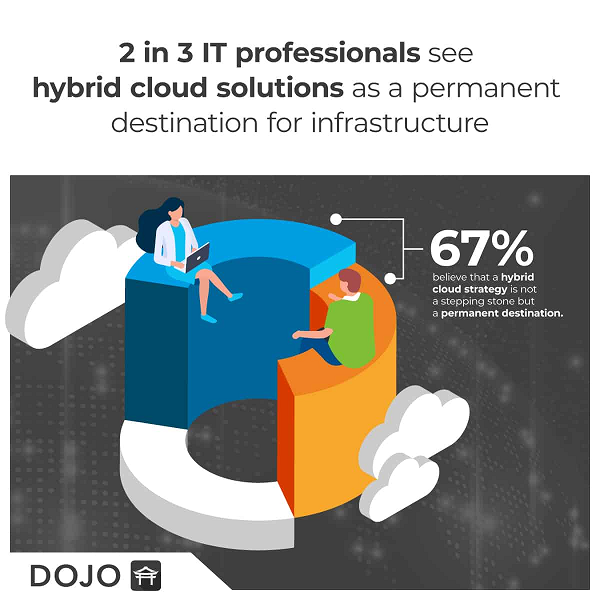With each passing year, the data systems that organizations depend upon become increasingly complex. As hybrid multicloud IT strategies become the norm for more companies, they’re searching for the best ways to use different infrastructures.
Most respondents to the 2023 Enterprise Cloud Index survey of nearly 1,500 global IT decision makers said they use more than one type of IT infrastructure, whether it is a mix of private and public clouds, multiple public clouds, or an on-premises data center along with a hosted datacenter. That number is expected to grow to nearly three quarters (74%) in the near future.
However, mixed infrastructures create new management challenges, and 94% of respondents say they'd benefit from having a single, unified place to manage applications and data across their diverse environments.
The more they spend using hybrid multicloud systems, the efficient these IT teams will get at managing applications and data across different IT infrastructure.
Key Takeaways:
- Edge computing can find a strong foothold in hybrid cloud environments, giving organizations easier access to low-latency network solutions.
- The IT industry will focus on security as cloud environments grow increasingly complex.
- Artificial intelligence and machine learning are likely to reach more consumers as a solution for managing large distributed networks.
- Low-code and no-code services will become a boon for smaller companies and teams looking to embrace cloud-native workloads despite possessing minimal resources.
What Constitutes a Meaningful Hybrid Cloud Scenario?
Hybrid clouds are elegant solutions to many problems that modern businesses face. The hybrid cloud environment contains both private clouds based in on-premises infrastructure and public clouds provided through a third-party service. This approach allows organizations to store sensitive data in the closely-guarded private cloud while saving space and reducing upkeep costs by allocating other workloads to a reliable vendor platform.
Cloud technology is constantly evolving, however, giving rise to new hybrid cloud scenarios that bring both challenges and benefits to consumers and providers alike.
Effectively managing a hybrid cloud entails balancing costs between private and public environments, as well as weighing security risks. Every technological advancement and industry-relevant news story can create a scenario that changes the factors a business leader must consider when making important IT decisions.
Scenarios with lasting effects or hard-hitting impacts inevitably reach the mainstream, becoming an everyday part of the hybrid multicloud discussion. The most meaningful of these scenarios are those that drive cloud technology toward a future where businesses of any size can effectively utilize it.
Hybrid Multicloud Solutions See Wider Adoption
More organizations are creating and using cloud-native applications. By packaging application code as containers, it is possible for the software to natively utilize resources, services, and infrastructure directly from a cloud computing platform. Through this methodology, organizations can accelerate app development and easily scale or even port their workloads across environments.
Despite the near-ubiquitous nature of cloud-native applications, though, a cloud-only strategy is becoming increasingly costly. This may drive many enterprises back toward an on-premises infrastructure or, more likely, a hybrid cloud scenario.
According to a survey from Altaro, 67% of IT professionals see a hybrid cloud strategy as a permanent solution for addressing infrastructure needs. The same survey also indicates that approximately one-third of tech companies have trust issues with the public cloud, exemplifying a necessity for maintaining a certain degree of private infrastructure in an organization’s cloud strategy to protect sensitive data.
Source: Altaro
67% of IT professionals believe a hybrid cloud strategy is ideal
Companies also recognize the need for multiple clouds from different vendors to meet any specific need. Costs, architecture, and governance can vary between providers, meaning that one cloud might be the best choice for a certain application while another cloud may be better suited to a different workload. Diversifying across multiple clouds also minimizes downtime in the event that one vendor experiences an outage.
As more and more companies adopt hybrid cloud scenarios with an emphasis on the multicloud dynamic, it also becomes necessary to have a simple way to manage such a complex environment. Nutanix Cloud Clusters (NC2) allows organizations to replicate their private cloud-like data center and run it in an AWS or Azure public cloud. This means IT teams don’t need to refactor or replatform applications and workloads.
They can use one common control plane from on-premises to the cloud, allowing them to use existing IT processes, skills and toolsets. They can automatic scale-up and shrink with fast, just-in-time provisioning keeps cloud costs to a minimum. And they can move workloads quickly across private and public clouds.
Edge Computing in Hybrid Cloud Environments Becomes Commonplace
Edge computing refers to an architecture in which the processing of client data occurs at the periphery or “edge” of a network, closer to the originating source. This technique serves to reduce response time and conserve bandwidth. Common applications of edge computing include:
- Reinforced data privacy
- Real-time analytics
- Driver assistance in smart vehicles
- Reduced latency for IoT devices, cloud gaming, and more
The growth of edge computing allows for the emergence of an exciting new hybrid cloud scenario. The edge is still a developing area of the IT industry seeking a strong foothold in the mainstream. That foothold might exist in the hybrid cloud.
Edge computing in hybrid cloud environments entails capitalizing on the underlying principles of both methodologies to further reduce computational latency. The concept of the edge is highly compatible with hybrid cloud solutions, and the two can co-exist in a few different ways.
One approach is to use an edge device in tandem with a public cloud, creating a different type of hybrid environment that does not follow the norm of utilizing a private cloud.
When it is necessary to use public cloud computing resources, it is possible to run the application on an edge device that plays a master role in relation to the public cloud. This is a viable approach when the edge device requires more processing power, but it is not necessary to store data in the public cloud for the sake of running the application.
Another hybrid cloud scenario involving the edge is to pair an edge device to the entire hybrid cloud. This means that the edge device communicates with both a private and public cloud.
Organizations Address Existing and Emerging Security Concerns
There is a clear and undeniable need for stronger security practices as companies migrate more and more of their processes to the cloud. In doing so, these companies need to anticipate and overcome longstanding security concerns as well as future threats.

These future threats may come in the form of malicious parties seeking to exploit the system as hybrid multicloud environments become increasingly complex. Technology advances at a staggering rate, but cybercriminals are only too eager to keep pace and use every conceivable advantage to further their own goals. Companies and government bodies, however, historically tend to struggle under the weight of bureaucracy when conforming to new and developing tech ecosystems.
Common security weaknesses in hybrid cloud scenarios are often the result of factors such as lack of visibility of misconfigurations, compromises made to achieve legal compliance, and human error.
Proactive government regulations and an increased emphasis on security spending are ways to address these weaknesses. The United States federal budget for the fiscal year 2023 takes a step in the right direction with proposed spending of $65 billion on IT at civilian agencies, up from the $58.4 billion proposed for the 2022 budget.
AI-powered solutions for predicting and catching cyber threats present another method of compensating for weaknesses in the hybrid multicloud environment. Organizations that lack the massive manpower required to monitor a huge multicloud network and proactively detect security risks can turn to artificial intelligence as more AI applications reach the mainstream.
Artificial Intelligence Takes the Reins in Cloud Computing
Artificial intelligence and machine learning clearly have a large role to play in cloud security, but these powerful technologies also have a place in many other hybrid cloud scenarios that will arise in 2023 and beyond.
AI and machine learning will become more predominant in the cloud computing space, especially in multicloud environments and distributed networks where AI solutions powered by machine learning can streamline the task of managing these complex systems.
Large distributed networks are necessary for providing the vast amounts of storage that customers seek when adopting a multicloud strategy. Without AI-powered tools, however, the manpower costs of monitoring and maintaining these complex networks can negate the expected return on investment.
The coming year is also likely to see increased use of AI to regulate power and cooling systems within data centers, further streamlining and simplifying the upkeep process involved with maintaining an on-premises infrastructure system. By implementing machine learning in this and similar ways, companies can cut long-term costs associated with various hybrid cloud scenarios and even reduce their carbon footprint through energy conservation.
Low-Code and No-Code Services Empower New Hybrid Cloud Scenarios
Low-code and no-code platforms are those which allow end users to develop applications with minimal programming knowledge. This typically comes in the form of a visual interface that allows the user to create a product by combining application components via a drag-and-drop method or a similarly simple process.
Low-code and no-code services empower organizations to create worthwhile applications even without the resources or in-house expertise to do so from scratch.
In addition to benefitting app developers, low/no-code solutions also allow IT teams to automate processes and customize cloud environments. Enterprises can build up their own hybrid cloud scenarios without the need to train, re-train, and onboard IT personnel as skill sets go out of date.
Many cloud service providers will begin offering low-code and no-code solutions in their offerings or expand their existing offerings in 2023. This increases the value that consumers will get from their cloud environment and allows them to take greater control even when managing multiple clouds from several different vendors.
Organizations to whom low/no-code solutions appeal should carefully consider their options before committing to a platform provider. Nutanix prioritizes simplicity for its customers, whether that means enabling end users to access and utilize automation tools through a low-code solution or hiding the complexity behind even the most traditional hybrid cloud scenario.
Learn more about how Nutanix streamlines hybrid multicloud management and the role of automation in cloud computing and various other facets of IT.
Michael Brenner is a keynote speaker, author and CEO of Marketing Insider Group. Michael has written hundreds of articles on sites such as Forbes, Entrepreneur Magazine, and The Guardian and he speaks at dozens of leadership conferences each year covering topics such as marketing, leadership, technology and business strategy. Follow him @BrennerMichael
© 2023 Nutanix, Inc. All rights reserved. For additional legal information, please go here.







